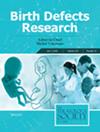A Comparison of Active and Passive Surveillance Strategies for Selected Birth Defects in New York
Abstract
Background
The New York State Birth Defects Registry (BDR) has passive and active components. As part of statewide passive ascertainment, the BDR receives reports of International Classification of Diseases, Tenth Revision (ICD-10) codes and descriptive narratives on a wide range of birth defects. The BDR conducts enhanced active surveillance for selected birth defects in 14 counties, which includes medical record abstraction and clinician review. We sought to quantify agreement between the two surveillance approaches.
Methods
The analysis included live-born infants born with one of the 16 birth defects in 2018–2021 in the active surveillance counties (n = 1069 infants). We calculated positive predictive values (PPV) and 95% confidence intervals for each defect, defined as the percentage of cases confirmed in active surveillance among those in passive surveillance. Additionally, we calculated the percentage with each birth defect missed by passive surveillance.
Results
The PPV varied greatly by birth defect. The PPV was >90% for gastroschisis and cleft lip, but <70% for spina bifida, diaphragmatic hernia, truncus arteriosus, tricuspid atresia, hypoplastic left heart syndrome, coarctation of the aorta, and pulmonary atresia. The percentage missed by passive surveillance ranged from 2% for tetralogy of Fallot to 39% for tricuspid atresia.
Conclusions
Active surveillance is an important strategy for ruling out false positive case reports for certain birth defects that we assessed, but not all of them. Passive surveillance programs can use our findings to develop targeted strategies for improving data quality of specific birth defects using active surveillance methods, thus optimizing limited resources.

 求助内容:
求助内容: 应助结果提醒方式:
应助结果提醒方式:


